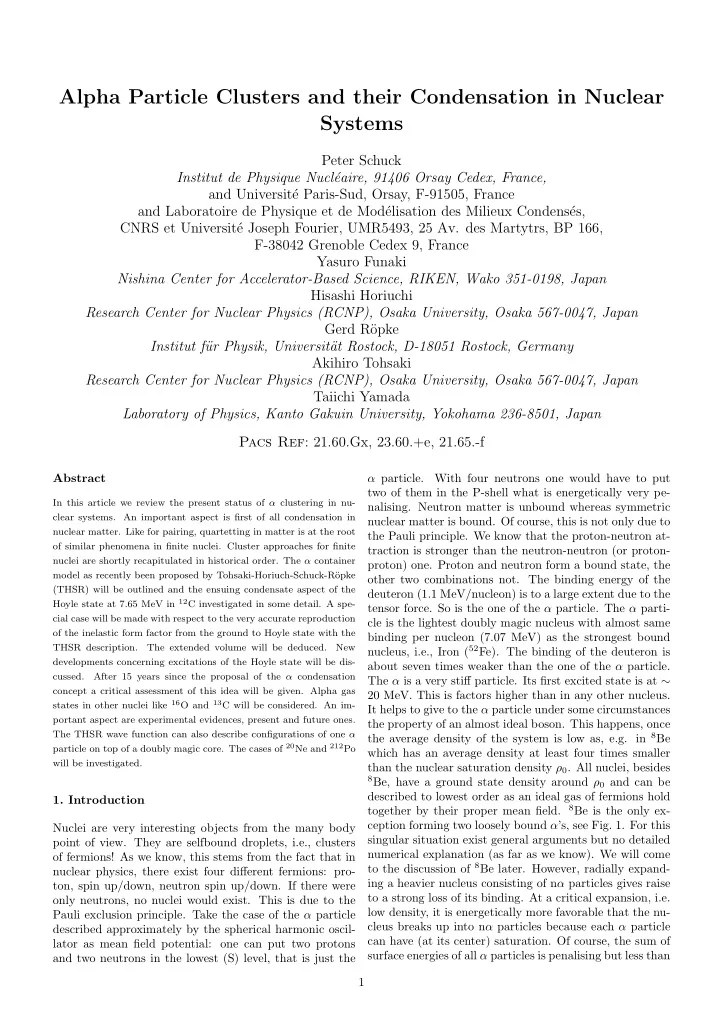

Alpha Particle Clusters and their Condensation in Nuclear Systems Peter Schuck Institut de Physique Nucl´ eaire, 91406 Orsay Cedex, France, and Universit´ e Paris-Sud, Orsay, F-91505, France and Laboratoire de Physique et de Mod´ elisation des Milieux Condens´ es, CNRS et Universit´ e Joseph Fourier, UMR5493, 25 Av. des Martytrs, BP 166, F-38042 Grenoble Cedex 9, France Yasuro Funaki Nishina Center for Accelerator-Based Science, RIKEN, Wako 351-0198, Japan Hisashi Horiuchi Research Center for Nuclear Physics (RCNP), Osaka University, Osaka 567-0047, Japan Gerd R¨ opke Institut f¨ ur Physik, Universit¨ at Rostock, D-18051 Rostock, Germany Akihiro Tohsaki Research Center for Nuclear Physics (RCNP), Osaka University, Osaka 567-0047, Japan Taiichi Yamada Laboratory of Physics, Kanto Gakuin University, Yokohama 236-8501, Japan Pacs Ref : 21.60.Gx, 23.60.+e, 21.65.-f Abstract α particle. With four neutrons one would have to put two of them in the P-shell what is energetically very pe- In this article we review the present status of α clustering in nu- nalising. Neutron matter is unbound whereas symmetric clear systems. An important aspect is first of all condensation in nuclear matter is bound. Of course, this is not only due to nuclear matter. Like for pairing, quartetting in matter is at the root the Pauli principle. We know that the proton-neutron at- of similar phenomena in finite nuclei. Cluster approaches for finite traction is stronger than the neutron-neutron (or proton- nuclei are shortly recapitulated in historical order. The α container proton) one. Proton and neutron form a bound state, the model as recently been proposed by Tohsaki-Horiuch-Schuck-R¨ opke other two combinations not. The binding energy of the (THSR) will be outlined and the ensuing condensate aspect of the deuteron (1.1 MeV/nucleon) is to a large extent due to the Hoyle state at 7.65 MeV in 12 C investigated in some detail. A spe- tensor force. So is the one of the α particle. The α parti- cial case will be made with respect to the very accurate reproduction cle is the lightest doubly magic nucleus with almost same of the inelastic form factor from the ground to Hoyle state with the binding per nucleon (7.07 MeV) as the strongest bound THSR description. The extended volume will be deduced. New nucleus, i.e., Iron ( 52 Fe). The binding of the deuteron is developments concerning excitations of the Hoyle state will be dis- about seven times weaker than the one of the α particle. cussed. After 15 years since the proposal of the α condensation The α is a very stiff particle. Its first excited state is at ∼ concept a critical assessment of this idea will be given. Alpha gas 20 MeV. This is factors higher than in any other nucleus. states in other nuclei like 16 O and 13 C will be considered. An im- It helps to give to the α particle under some circumstances portant aspect are experimental evidences, present and future ones. the property of an almost ideal boson. This happens, once The THSR wave function can also describe configurations of one α the average density of the system is low as, e.g. in 8 Be particle on top of a doubly magic core. The cases of 20 Ne and 212 Po which has an average density at least four times smaller will be investigated. than the nuclear saturation density ρ 0 . All nuclei, besides 8 Be, have a ground state density around ρ 0 and can be described to lowest order as an ideal gas of fermions hold 1. Introduction 8 Be is the only ex- together by their proper mean field. ception forming two loosely bound α ’s, see Fig. 1. For this Nuclei are very interesting objects from the many body singular situation exist general arguments but no detailed point of view. They are selfbound droplets, i.e., clusters numerical explanation (as far as we know). We will come of fermions! As we know, this stems from the fact that in to the discussion of 8 Be later. However, radially expand- nuclear physics, there exist four different fermions: pro- ing a heavier nucleus consisting of n α particles gives raise ton, spin up/down, neutron spin up/down. If there were to a strong loss of its binding. At a critical expansion, i.e. only neutrons, no nuclei would exist. This is due to the low density, it is energetically more favorable that the nu- Pauli exclusion principle. Take the case of the α particle cleus breaks up into n α particles because each α particle described approximately by the spherical harmonic oscil- can have (at its center) saturation. Of course, the sum of lator as mean field potential: one can put two protons surface energies of all α particles is penalising but less than and two neutrons in the lowest (S) level, that is just the 1
Recommend
More recommend